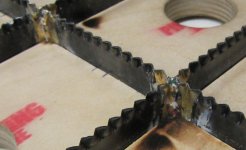Jason H
Stainless
- Joined
- Mar 29, 2006
- Location
- Los Angeles, CA.
This is a steel rule die that is made for me by an outside company. The stresses on the unit cause the brazed portion to crack and then when the die cuts fabric the cracks catch the fabric and cause problems.
I have a Miller 250 Sync, a small OA rig, and a Lincoln Mig set up. I have never brazed in my life, can I just Tig these sections and grind it back out?
Treat me nice, yes I am still green.


I have a Miller 250 Sync, a small OA rig, and a Lincoln Mig set up. I have never brazed in my life, can I just Tig these sections and grind it back out?
Treat me nice, yes I am still green.



